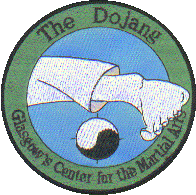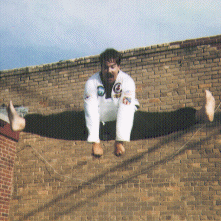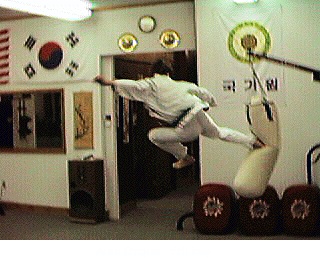The
Dojang
Glasgow's
Premiere
Training
For
The
Martial
Arts

 The Dojang teaches Tae Kwon Do from the roots of the Korean
Tae Kwon Do Ji Do Kwan, with significant additional enhancements to the
training content.
The Dojang teaches Tae Kwon Do from the roots of the Korean
Tae Kwon Do Ji Do Kwan, with significant additional enhancements to the
training content.
We train each Monday, Wednesday and Friday evening beginning at 7:30 p.m. for warmup and stretching activities prior to class. Formal class begins once everyone is warmed up and stretched out, and the class ends at 9:00 p.m. Students pay a single fee per month in advance, which entitles them to attend as many classes as they wish, or as few, in that month. There are no contracts. Students are required to sign a comprehensive disclaimer. There is a basic goal in terms of number of classes that will give the student an idea of remaining time until they may be considered as ready to advance.
In the course of gup level training, students are taught to read and write using Hangul, the native Korean characters. Optionally, they are also taught to deal with Hanja, the adopted Chinese characters used in Korean writing. The class is taught in Korean, and students must learn all technique names in both Korean and English.
 Students receive as a normal part of their training a complete set of
detailed notes
bound in a 3-ring folder. As a student advances from 10th gup towards
1st gup and eventually 1st dan, at each successful examination they are
presented with the notes for their new gup along with the new belt or
stripe, and certificate. These notes serve as a reference for the
student during periods when they must be away from the training as well
as a point by point refresher useful during active periods. They contain
the training documents for the Korean writing system, form descriptions,
self-defense techniques, new terms, and set out the examination
requirements for the next rank test. Also included is a short history of
Tae Kwon Do, a section on the legal ramifications of martial arts
training, instructions for proper stretching and warmup, and other basic
information useful to the student.
Students receive as a normal part of their training a complete set of
detailed notes
bound in a 3-ring folder. As a student advances from 10th gup towards
1st gup and eventually 1st dan, at each successful examination they are
presented with the notes for their new gup along with the new belt or
stripe, and certificate. These notes serve as a reference for the
student during periods when they must be away from the training as well
as a point by point refresher useful during active periods. They contain
the training documents for the Korean writing system, form descriptions,
self-defense techniques, new terms, and set out the examination
requirements for the next rank test. Also included is a short history of
Tae Kwon Do, a section on the legal ramifications of martial arts
training, instructions for proper stretching and warmup, and other basic
information useful to the student.
Forms are the central, critical part of the instruction for our students. Thirty one patterns are learned in the process of working through the gup ranks towards first dan. Students execute every hyung from 10th gup to their current rank in every class. That means, for instance, that our red belts do the white belt forms every day. Our forms include traditional Tae Kwon Do forms from the original Ji Do Kwan curriculum, the "new" Palgwe forms, and the "really new" Taeguek forms as well.
 In the black belt ranks (dan), we
teach the WTF forms (Koreo, Keumgang, etc.) as well as Bassai Dai,
Shipsu and related older traditional forms. Each dan ranking encompasses
a number of technically challenging techniques as well as the new forms.
In the black belt ranks (dan), we
teach the WTF forms (Koreo, Keumgang, etc.) as well as Bassai Dai,
Shipsu and related older traditional forms. Each dan ranking encompasses
a number of technically challenging techniques as well as the new forms.
We do not use the "poom" designation for black belt ranking for younger students. All students, regardless of age, are subjected to the same testing requirements. This includes an essay, technical martial arts, language, and more. If the test cannot be passed to the satisfaction of the master instructor, the rank is not awarded. As a result, very young black belts are unexpected, and the issue of a "poom" has yet to arise. There are serious issues regarding maturity and self-knowledge that the black belt test deals with. If those issues are not dealt with in a satisfactory manner, then the individual is not deemed ready for the rank. The youngest black belt that has been ranked as a result of our training was 17 at the time.
For any yudanja (black belt), qualification for the next higher dan ranking consists of the new forms, the new techniques, and a minimum number of class hours which is equal to the number of years for the next dan ranking. In other words, the minimum time to promote from first dan to second dan is two years; then three years to third dan and so forth.
If a dan-ranked student of ours receives a formal dan ranking in another martial art (Judo, Karate, Hapkido, etc.) or a different style of Tae Kwon Do (ITF, ATA, etc.) then a 50% credit for the required class hours in our dojang is applied. This is given to encourage broad study in the belief that the wider a martial artist's knowledge base, the more effective the martial artist becomes. The class hour credit does not reduce the minimum time between dan rankings; what it does is provides leeway to practice elsewhere and not "lose" all of the the time at our school or under our instruction and training methods. Performance of all techniques and patterns to the same level of excellence are still required of the yudanja at test time.
The Dojang's belt ranking system complies with the WTF standard:
- 10th gup: White
- 9th gup: Yellow
- 8th gup: Yellow, green stripe
- 7th gup: Green
- 6th gup: Green, blue stripe
- 5th gup: Blue
- 4th gup: Blue, red stripe
- 3rd gup: Red, one black stripe
- 2nd gup: Red, two black stripes
- 1st gup: Red, three black stripes
A typical class goes something like this:
| Warmup & stretching | (performed prior to class) |
| Single hand techniques | 28, alternating single blocks, strikes, etc. 10 counts |
| Single foot techniques | 12, Basic single kicks, 10 each side |
| Combination hand techniques | 9, 2-5 strike/block combinations |
| Combination foot techniques | 5, 2-3 kick combinations |
| Patterns | 31, or more, depending on dan students present |
| Matwork, self-defense, drills, sparring, etc. | Changes every day |
| Cooldown | (performed after class) |
Here is a table of patterns used in various TKD styles.
Classes are presently held in our private dojang. Classes are restricted to a selected membership due to space limitations.
Questions or Comments about The Dojang? sabumnim@dojang.com
Last page update: August 30th, 2017